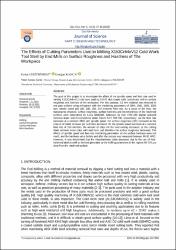| dc.contributor.author | Ceritbinmez, Ferhat | |
| dc.contributor.author | Kanca, Erdoğan | |
| dc.date.accessioned | 2022-12-22T06:01:19Z | |
| dc.date.available | 2022-12-22T06:01:19Z | |
| dc.date.issued | 2022 | en_US |
| dc.identifier.citation | Ceritbinmez, F. Kanca, E. (2022). The Effects of Cutting Parameters Used in Milling X153CrMoV12 Cold Work Tool Steel by End Mills on Surface Roughness and Hardness of The Workpiece . Gazi University Journal of Science Part C: Design and Technology, 10 (1) , 27-38.
https://doi.org/10.29109/gujsc.1017383 | en_US |
| dc.identifier.uri | https://doi.org/10.29109/gujsc.1017383 | |
| dc.identifier.uri | https://dergipark.org.tr/tr/pub/gujsc/issue/68936/1017383 | |
| dc.identifier.uri | https://hdl.handle.net/20.500.12508/2443 | |
| dc.description.abstract | The goal of this project is to investigate the effect of the spindle speed and feed rate used in milling X153CrMoV12 cold work steel by X5070 blue coated solid carbide end mill on surface roughness and hardness of the workpiece. For this purpose, 0.2 mm material was removed in one pass without using refrigerant with the machining parameters of 2000, 2500, 2800, 3000 rpm spindle speed and 160, 180, 200, 240 mm/min feed rate. As a result of the tests, the topographic structure, surface roughness, surface hardness and microhardness of the machined surfaces were determined by Leica DMS300, Mitutoyo SJ 210, HRS-150 digital rockwell hardness tester and microhardness tester Future-Tech FM-700, respectively. As the feed rate increased at a constant 2800 rpm spindle speed, the surface roughness (SR) increased as the amount of metal removed per unit time increased. As the spindle speed increased at a constant feed rate of 180 mm/min, the amount of chips for the next cutting decreased, as the cutting blade removed more chips with each turn, and therefore the surface roughness decreased. The effects of spindle speed and feed rate machining parameters on the surface hardness were not much, and the hardness value before and after the process was measured between 60-62 HRC. However, it was determined that the microhardness value decreased due to the use of heathardened steel as well as the heat generated by the milling parameters in the regions 50-350 µm deep from the machined surface. | en_US |
| dc.language.iso | eng | en_US |
| dc.publisher | Gazi Üniversitesi | en_US |
| dc.relation.isversionof | 10.29109/gujsc.1017383 | en_US |
| dc.rights | info:eu-repo/semantics/openAccess | en_US |
| dc.subject | Milling | en_US |
| dc.subject | Microhardness | en_US |
| dc.subject | Surface roughness | en_US |
| dc.subject | Surface hardness | en_US |
| dc.subject.classification | Mühendislik | |
| dc.subject.classification | Tasarım ve Teknoloji | |
| dc.title | The Effects of Cutting Parameters Used in Milling X153CrMoV12 Cold Work Tool Steel by End Mills on Surface Roughness and Hardness of The Workpiece | en_US |
| dc.type | article | en_US |
| dc.relation.journal | Gazi Üniversitesi Fen Bilimleri Dergisi Part C: Tasarım ve Teknoloji | en_US |
| dc.relation.journal | Gazi University Journal of Science Part C: Design and Technology | |
| dc.contributor.department | Mühendislik ve Doğa Bilimleri Fakültesi -- Makina Mühendisliği Bölümü | en_US |
| dc.identifier.volume | 10 | en_US |
| dc.identifier.issue | 1 | en_US |
| dc.identifier.startpage | 27 | en_US |
| dc.identifier.endpage | 38 | en_US |
| dc.relation.publicationcategory | Makale - Ulusal Hakemli Dergi - Kurum Öğretim Elemanı | en_US |
| dc.contributor.isteauthor | Kanca, Erdoğan | |
| dc.relation.index | TR-Dizin | en_US |
















